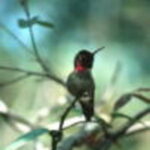Sloth bears have a long and shaggy coat of brown or black fur and are somewhat disheveled looking. These bears usually have white or yellowish markings on their chests and may also have white paws and/or muzzles. They are found in the lower elevations of Bangladesh, Bhutan, Sri Lanka, Nepal and India. Male and female Sloth bears don’t differ greatly in height or length. They can grow to be over six feet long and in the neighborhood of 3 feet tall to the shoulder when on all fours. Females are generally lighter than males and weigh between 120 and 220 pounds. Males usually weigh in between 200 and 320 pounds. They make their dens in a variety of environments depending on weather and climate. Sloth bears are known to live in forests and grasslands as well as more tropical regions. Although their life span in the wild is unknown, these fuzzy and playful creatures have lived as long as forty years in captivity.
The Sloth bear will not reach sexual maturity until three to four years of age and often begins breeding soon after. Mating is seasonal in some countries, like India, where mating only occurs between the months of April and June. In other countries, Sri Lanka for one, Sloth bears have been known to mate at any time of the year. When mating, Sloth bears are very loud and will frequently engage in rough play or mock fighting. Sloth bears have the ability to delay fertilization of the egg if their food supply is not plentiful enough but once fertilized the gestation period is anywhere from 180 to 210 days. Cubs are generally born during the dry season which occurs in December or January with the birth taking place in a cave, a den or in shelters underneath large rock formations. Litters consist of one to three cubs whose weight at birth averages between 10.5 and 17.5 ounces.
Newborn Sloth bear cubs are quite tiny and blind at birth. Despite those limitations their toes and their legs, especially the front, are extremely strong. They will begin to use their eyes about three weeks from birth and start stumbling around on their own a week or two later. Cubs stay with their mothers for upwards of three years depending on how quickly they learn to care for themselves but may seek independence as early as two years. They continue to drink their mother’s milk until separation but begin to supplement their diet with other foods at two to three months of age. In the wild, the diet of the Sloth bear varies according to their regional habitat as well as the season. Sloth bears are omnivorous and are known to feast on such delicacies as termites, grubs and other insects, carrion, fruits, berries, grasses, honey and eggs. They have even been known to raid cultivated crops.
Sadly, the Sloth bear is on the endangered species list and less than 10,000 remain in the wild. Their existence is threatened by a variety of problems including deforestation, scattered populace, competition with other animals (mostly people) for land and food and they are still being hunted in many Asian countries for the bear parts trade. Bear parts are used in many Asian medicines and while protection for the Sloth bear is improving, there are still many countries that allow them to be hunted and the bear parts trade is still largely unrestricted. Like many endangered species, these bears will not survive without more protected habitat and increased restrictions on hunting. Find out what can be done to insure the survival of these magnificent creatures before it’s too late.







